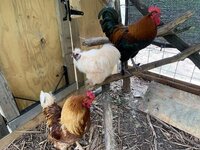Yorkshiregal
Songster
Hi so I’ve read a lot about keeping roosters together. I have 7. Two of my handsome golden laced Wyandotte’s became very bossy and big quickly so we moved them to an acre where it’s pretty secure. They have a coop for themselves and seem to be doing great. We tried to move one of our rooster bantam silkies with them and it looked like they were trying to kill him. They were all raised together mind you so I thought it would be cool! Nope So we took him out and put him back with the flock. Turns out I have four bantam silkie terrors. They are pretty small but are attacking my hens gang style!!! I want to know if I should try and put the 4 Back with the big guys? Or keep them completely separate, integrate them slowly or just build them their own coop and run. I don’t think these roosters would be good eating? So that’s not an option? Also is it better to have them completely out of site from the hens? We are going to start building something this weekend but not sure where. I’ve e read as much as possible but I’d like some extra input thanks so much!



